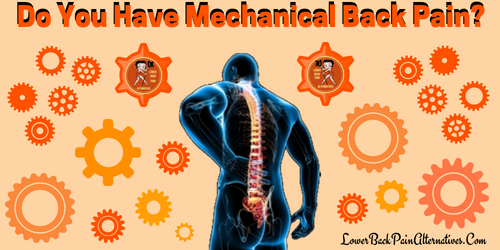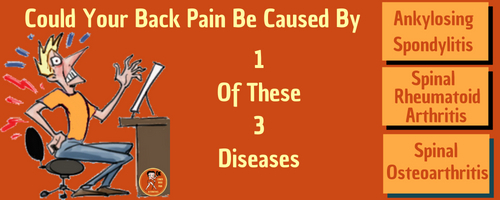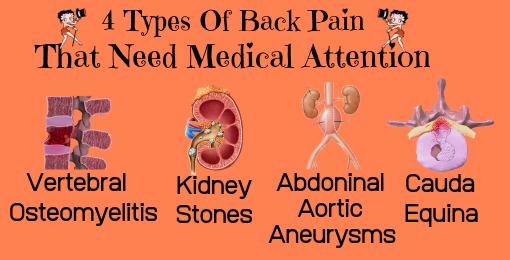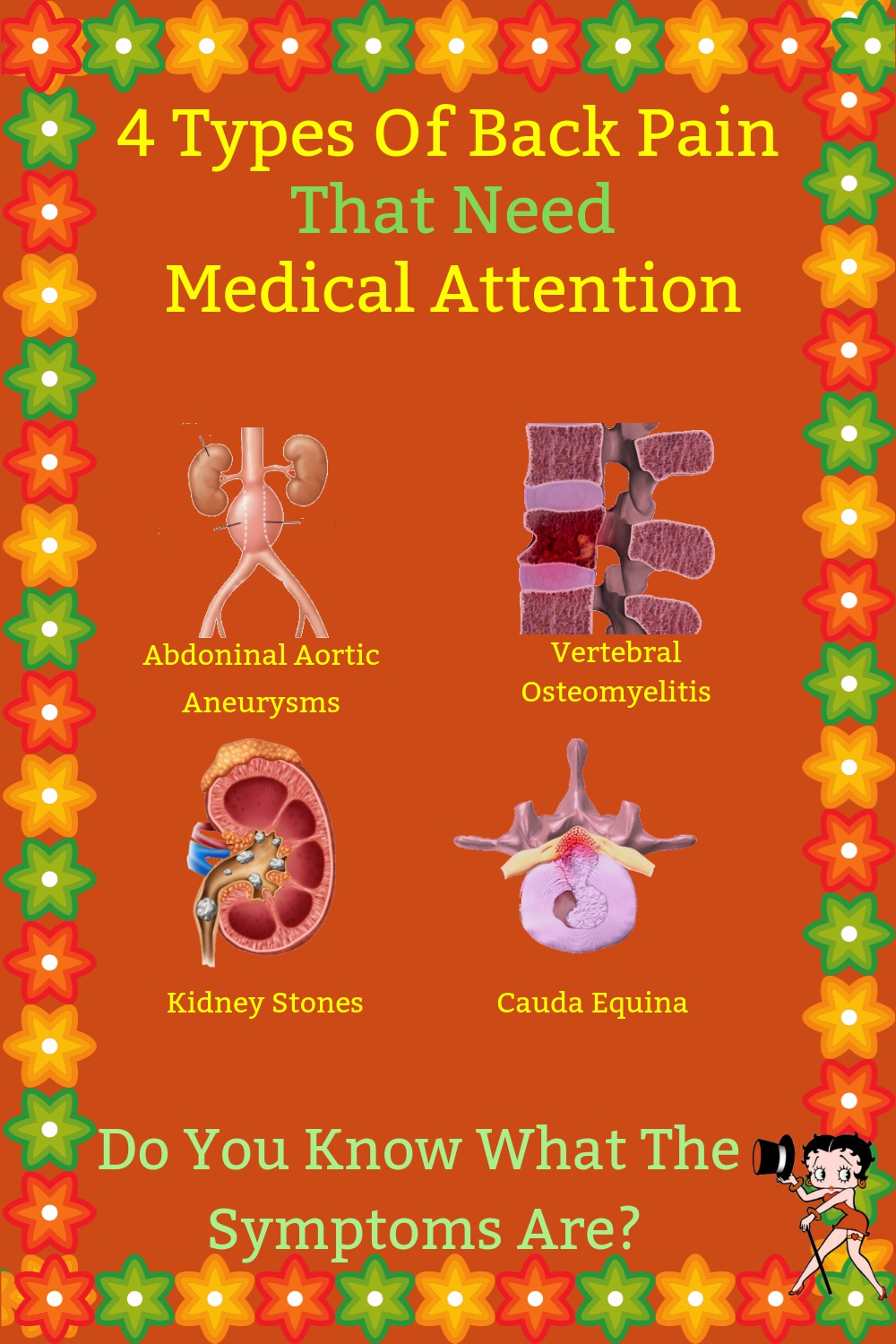
Mechanical Back Pain is pain caused by mechanical problems in the muscles, joints, bones, & tissues. It’s usually related to the lumbar spine’s gradual degeneration.
Bit by bit your spine deteriorates as you age. This degeneration is caused by the normal wear and tear of the bones, discs, and joints of the spine.

1. 10 Types Of Mechanical Back Pain + Symptoms
2. 3 Types Of Spine Disease + Symptoms
3. 4 Back Pain Symptoms That Require Medical Attention
MECHANICAL BACK PAIN SYMPTOMS
Listed below are 10 types of Mechanical Back Pain. I’ll provide you with a brief definition of each one and what the most common symptoms are.
If you’re experiencing any of the chronic back pain symptoms below, don’t assume that’s what you have. Have your doctor run some tests to verify that you’re right. Once it’s verified by your doctor, then look into the alternatives that are available.
For alternatives that can help these conditions, take a look at my:
1. HERNIATED (ruptured) DISCS: Herniated discs can occur when the intervertebral discs become compressed and bulge outward (herniation) or rupture, causing low back pain
SYMPTOMS: If you have a herniated disk in your lower back you’ll probably feel the most intense pain in your buttocks, calf & thigh. You may also feel pain in part of your foot.
There’s a chance that you could be experiencing tingling or numbness in the part of your body that’s affecting the nerves. Muscles that are served by the affected nerves tend to weaken. If this is the case, you might find yourself stumbling or having difficulty lifting or holding items.
2. INTERVERTEBRAL DISC DEGENERATION: It’s also known as, Degenerate Disc Disease. This disease is the most common cause of mechanical low back pain. It’s when your discs lose their integrity. They become less and less rubbery. The intervertebral discs start losing their height.
SYMPTOMS: Because the discs seem to lose their cushioning ability, you find it harder to bend and twist.
3. RADICULOPATHY: Radiculopathy is caused by a spinal nerve root being compressed, inflamed or injured. Radiculopathy can be caused when a herniated or ruptured disc or spinal stenosis compresses the nerve root.
SYMPTOMS: With Radiculopathy, there is pressure applied to the nerve root, which can cause numbness, pain, or a tingling sensation that travels to the area of the body that is served by that nerve.
4. SCIATICA: Sciatica is caused by the sciatic nerve being compressed. The sciatic nerve is the large nerve that runs through the buttocks and extends down the back of the leg. Sciatica can also be caused by a tumor or cyst that presses on the sciatic nerve or its roots.
SYMPTOMS: Shock-like or burning causing low back pain. It’s combined with pain through the buttocks and down one leg. Sometimes the pain reaches the foot but not always.
If the nerve is pinched between the disc & the adjacent bone, you might feel numbness & muscle weakness in the leg
5. SKELETAL IRREGULARITIES: Two such irregularities are Scoliosis and Lordosis.
SCOLIOSIS usually doesn’t affect you until middle age. It’s a curvature of the spine that causes pain.
LORDOSIS is when the spine curves too far inward. Because of the abnormally accentuated arch in the lower back, it causes back pain.
SYMPTOMS (Scoliosis): Scoliosis can reduce the flexibility in your spine. It can cause you to be stiff especially when you get out of bed in the morning, or you’re bending to pick something up. You sometimes feel quite a bit of pain when you’re sitting or standing in one spot for very long. I have Scoliosis, and I experience a lot of muscle tightness and stiffness.
SYMPTOMS (Lordosis): You can feel pain & discomfort and even have problems moving in certain ways. One way of telling if you have Lordosis is to lay on your back. People with Lordosis will have a noticeable gap between their lower back & the floor.
6. SPINAL STENOSIS: It’s a narrowing of the spinal column. The narrowing places pressure on the spinal cord and nerves.
SYMPTOMS: Spinal Stenosis can cause increased pain in the legs when walking. Some people experience tingling, weakness or numbness that radiates from the lower back into the buttocks and legs.
7. SPONDYLOLISTHESIS: It’s when the vertebra of the lower spine slips out of place. When it slips out of place, it pinches the nerves exiting the spinal column.
SYMPTOMS: With Spondylolisthesis, most people experience leg pain and lower back pain. Some people experience an arching in one or both legs, sciatic pain, or their legs feeling tired when they stand or walk for a prolonged period of time. You can also experience muscle tightness and stiffness.
8. SPRAINS & STRAINS: Sprains are caused by either tearing ligaments or overstretching. Strains are caused by tears in the muscle or tendon.
SYMPTOMS (Sprain): The symptoms can include bruising, pain, swelling. Pain is especially experienced when moving the affected joint. It can also trigger spasms in the back muscles.
SYMPTOMS (Strain): People can experience pain and general weakness in the muscles in the area of the strain, especially when they attempt to move it. You can also have localized swelling, cramping, or inflammation.
9. TRAUMATIC INJURY: A Traumatic injury to the back can cause the spine to become overly compressed. When your spine becomes compressed, it can cause an intervertebral disc to rupture or herniate. This in turn can cause pressure on any of the nerves that are rooted in the spinal cord.
EXAMPLE: Some examples of a traumatic injury would be an injury from the result of a, car accident, fall or playing sports. The accident can cause injuries to tendons, ligaments or muscle.
10. TUMORS: Tumors can begin in the back, but it’s rare. When tumors appear in the back, it can be a result of cancer that has spread from other parts of the body.
SYMPTOMS: Some of the symptoms of having a spinal tumor is, muscle weakness or numbness in the legs or arms, difficulty walking, pain in the back, arm or leg, difficulty urinating, change of bowl habits, general loss of sensation, or paralysis to varying degrees.

WHAT IS SPINE DISEASE?
There are three main types of Spine Disease. I’ll just give you a brief explanation of each one & their most common symptoms. Once again, if it seems you have all of the symptoms or just some, it doesn’t mean you have the disease. Save yourself a lot of time & money & check with your doctor first.
WHAT IS ANKYLOSING SPONDYLITIS?
Ankylosing spondylitis is a form of arthritis. It’s the chronic inflammation of the spine and the bone-to-tendon attachment area of the sacroiliac joint. It erodes the bone & increases bone formation in the spine. This can lead to the vertebrae in your spine to fuse. In advanced cases, it can cause spinal deformity.
SYMPTOMS: The three main symptoms of Ankylosing Spondylitis are: Pain, Stiffness & Loss of Mobility.
What you experience depends on the severity of the condition. At the beginning, people feel pain & stiffness in their lower back, hips or buttocks area. It usually occurs in the morning or after periods of inactivity. It also becomes harder & harder to bend the spine.
WHAT IS SPINAL OSTEOARTHRITIS?
Spinal Osteoarthritis is also known as degenerative arthritis of the spine. It’s the inflammation of the spinal facet joints. It’s a breakdown of the cartilage of the joints and discs in the neck and lower back. It sometimes produces spurs that put pressure on the nerves that leave the spinal column. Because of this pressure, it can cause the arms or legs to become painful or week.
SYMPTOMS: With Spinal Osteoarthritis, most people experience stiffness or low back pain. The stiffness is worse when you wake up & worsens at the end of the day. The cause of this could be because of the fluid that builds up in the joint overnight. You may not be able to move your joint through its full range of motion. In more severe cases it can also cause numbness or weakness in the arms or legs. The stiffness quite often eases with activity.
WHAT IS SPINAL RHEUMATOID ARTHRITIS?
Spinal Rheumatoid Arthritis is an autoimmune disorder. It’s a type of arthritis that affects the joints of the spine.
The body’s defense system attacks the synovium (lubricant) in the facet joints, causing the membrane to become inflamed and thick. The facet joints swell and stop their lubrication production. They become stiff, swollen and painful. This in turn causes damage to the cartilage on the joints. Bone spurs often form as joints become deformed. As it progresses, spinal muscles and ligaments start to weaken.
SYMPTOMS: With Spinal Rheumatoid Arthritis, you could experience, warm & painful joints, Fever, Deformity of the spine, swelling & tenderness, trouble walking, Ankylosis, fatigue and morning stiffness.
If you have any of the above health conditions, and you’ve had it verified by your doctor, take a look at my Back Pain Relief Products, to help alleviate your pain.

BACK PAIN SYMPTOMS THAT NEED MEDICAL ATTENTION
It’s not too often, but there are instances where your back pain could be caused by underlying conditions. When these back pain Symptoms occur, they require immediate medical attention.
■ ABDOMINAL AORTIC ANEURYSMS: It occurs when the large blood vessel that supplies blood to the abdomen, legs, and pelvis becomes abnormally enlarged. Back pain can be a sign that the aneurysm is at risk of rupture.
SYMPTOMS: With this type of an aneurysm, some people experience a stabbing pain deep in the abdomen between the bellybutton & the sternum. The pain is continuous sometimes causing the person to double over. It’s sometimes difficult to stand or straighten the upper body.
■ CAUDA EQUINA SYNDROME: Cauda Equina Syndrome is the uncommon compression of the nerves at the end of the spinal cord within the spinal canal. It can be from the complication of a ruptured disc. The disc material gets pushed into the spinal canal. The disc material then compresses the bundle of sacral & lumbar nerve roots. It’s rare that someone’s back pain is caused by this, but when it is, it’s serious.
SYMPTOMS: The main symptoms of Cauda Equina syndrome include: Incontinence of bladder or bowels, low back pain, numbness in the anus area & lower extremities (sciatica), and the legs becoming week
■ KIDNEY STONES: Kidney stones are a solid, pebble-like piece of material. They can form in one or both of your kidneys. If left untreated, it can lead to kidney failure which is life threatening.
SYMPTOMS: A sharp pain in your lower back (usually on one side), lower abdomen, groin or side. You can also have blood in your urine. Symptoms can also include a constant need to urinate, pain while urinating, the inability to urinate or cloudy bad-smelling urine.
■ VERTEBRAL OSTEOMYELITIS: Vertebral Osteomyelitis is not a common cause of back pain. It’s a serious infection of a bone usually caused by bacteria. When osteomyelitis is in the spine, it’s usually found in the vertebrae. The bacteria can also spread into the epidural & intervertebral disc spaces.
SYMPTOMS: It causes severe back pain. The pain is persistent, aggravated by movement and worse at night. It can cause fever, sweating, swelling, vomiting & weight loss.

I hope the above information has helped you in some way. Thanks for stopping by, Lower Back Pain Alternatives & reading my article on, What Is Mechanical Back Pain.




Thank you Darlene for appreciating my comment , i love to read your articles and well thank you for sharing like these great information.
Hi Lisa,
You’re very welcome, I love it when someone leaves a comment. It’s great to know I’ve helped another person.
Thank you for sharing about the Mechanical back pain and their symptoms and advice.
Hi Georges,
Yes, stress does affect your back in negative ways. I’m glad you enjoyed my article. Thanks for dropping by.
Work and serious mental stress are factors which always trigger my low back pain.When sressors are relieved or controlled the pain decreases significantly. Thank you for comments and advice .